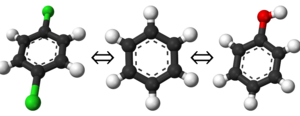Exponential Averaging
| Free Energy Fundamentals |
|---|
 |
|
Methods of Free Energy Simulations
|
| Free Energy How-to's |
|---|
 |
Exponential Averaging (EXP) is one of the earliest free energy methods available to researchers. Mostly used to evaluate between only two states of interest, it has an exact solution where as many other methods require approximations. Other names for this technique are the "Zwanzig Relationship" (named after the person who first derived it)[1] and "free energy perturbation (FEP)." To avoid confusion, the latter term should be avoided as it can easily be confused with other definitions in the scientific field.
Derivation
Starting from the statistical relation for free energy of
- [math]\displaystyle{ \displaystyle A = -\beta^{-1} \mathrm{ln}\, Q }[/math]
the free energy difference between two states with potentials [math]\displaystyle{ U_0(\vec{q}) }[/math] and [math]\displaystyle{ U_1(\vec{q}) }[/math] is simply
- [math]\displaystyle{ \displaystyle A_1 - A_0 = -\beta^{-1} \left[\mathrm{ln}(Q_1) - \mathrm{ln}(Q_0)\right] = -\beta^{-1} \mathrm{ln}\left[\frac{Q_1}{Q_0}\right] }[/math].
By then adding and subtracting [math]\displaystyle{ e^{-\beta U_0(\vec{q})} }[/math] from the integral in the partition function in the numerator, we get
- [math]\displaystyle{ \Delta A_{10} = -\beta^{-1} \mathrm{ln} \left[\frac{\int e^{-\beta \left(U_1(\vec{q})-U_0(\vec{q})+U_0(\vec{q})\right)} d\vec{q}}{Q_0}\right] = -\beta^{-1} \mathrm{ln} \left[\frac{\int e^{-\beta \left(U_1(\vec{q})-U_0(\vec{q})\right)} e^{-\beta U_0(\vec{q})} d\vec{q}}{Q_0}\right] }[/math]
which gives the final relationship of:
- [math]\displaystyle{ \displaystyle \Delta A_{10} = -\beta^{-1} \mathrm{ln} \left\langle e^{-\beta \left(U_1(\vec{q})-U_0(\vec{q})\right)} \right\rangle_0 = -\beta^{-1} \mathrm{ln} \left\langle e^{-\beta \Delta U(\vec{q})} \right\rangle_0 }[/math]
Estimating Free Energies and variance of EXP
Because EXP is a two state method, estimating free energies is straightforward and each state's individual variance is additive because there are only two.
For any given EXP calculation, you only need the [math]\displaystyle{ k }[/math] and one of the [math]\displaystyle{ k \pm 1 }[/math] states.
Limitations of EXP
Although this is an exact solution and one of the simplest methods to understand, it is also one of the poorest methods in terms of efficiency. The EXP method does not converge quickly with number of samples, and even converged results show a very poor phase space overlap[2][3] For these reasons, unless the potential energy distributions for all [math]\displaystyle{ \vec{q} }[/math] are known to be small (on the order of 1-2 [math]\displaystyle{ k_B T }[/math]), then EXP should not be used.
There are a few explicit cases where EXP is beneficial:
- Calculating the free energy difference between a cheap potential and a more expensive potential that are very close to each other. One can simulate at the cheap parameters and estimate results at the expensive parameters.
- If the unsampled "target" state's phase space is a subset of the simulated state, then EXP is much more accurate;[3][4][5][6][7] a rigid molecule insertion into a dense fluid is one such example.
Despite these cases, it is challenging to know the phase spaces a priori and even then, its not known which state is the best to sample from.
Lastly, EXP only uses two states worth of data for all of its calculations, limiting the ability to efficiently estimate more states.
References
- ↑ Zwanzig, R. W. (1954) High-Temperature Equation of State by a Perturbation Method. I. Nonpolar Gasses. J. Chem. Phys. 22, 1420–1426. - Find at Cite-U-Like
- ↑ Shirts, M. R., and Pande, V. S. (2005) Comparison of efficiency and bias of free energies computed by exponential averaging, the Bennett acceptance ratio, and thermodynamic integration. J. Chem. Phys. 122, 144107. - Find at Cite-U-Like
- ↑ 3.0 3.1 Lu, N. D., Singh, J. K., and Kofke, D. A. (2003) Appropriate methods to combine forward and reverse free-energy perturbation averages. J. Chem. Phys. 118, 2977–2984.
- ↑ Lu, N. D., and Kofke, D. A. (1999) Optimal intermediates in staged free energy calculations. J. Chem. Phys. 111, 4414–4423.
- ↑ Wu, D., and Kofke, D. A. (2005) Phase-space overlap measures. I. Fail-safe bias detection in free energies calculated by molecular simulation. J. Chem. Phys. 123, 054103. - Find at Cite-U-Like
- ↑ Wu, D., and Kofke, D. A. (2005) Phase-space overlap measures. II. Design and implementation of staging methods for free-energy calculations. J. Chem. Phys. 123, 084109. - Find at Cite-U-Like
- ↑ Jarzynski, C. (2006) Rare events and the convergence of exponentially averaged work values. Phys. Rev. E 73, 046105. - Find at Cite-U-Like